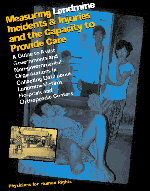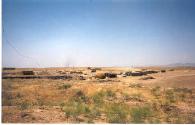
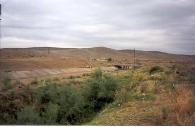
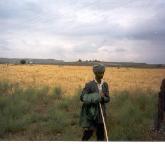

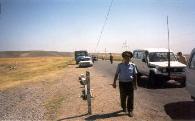
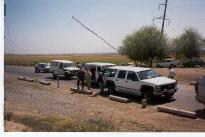
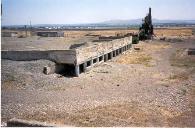
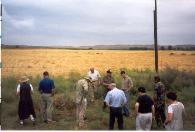
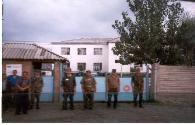
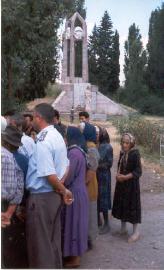
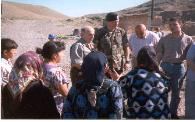
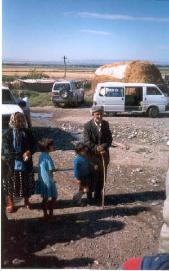

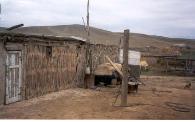
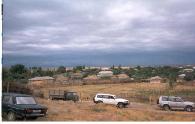
EXECUTIVE SUMMARY
In the aftermath of the conflict between Azerbaijan and Armenia over the
Nagorno-Karabakh region, an estimated 100,000 landmines are believed to
have been planted. The United Nations estimates that during this ten year
conflict there have been over 30,000 deaths and 700,000 refugees and
internally displaced persons (IDPs). In the future, as IDPs return to areas
where there was fighting, landmines may result in a major humanitarian crisis.
Through funding by the Canadian government, a team from Physicians for
Human Rights performed a survey of hospitals, orthopedic centers, and
communities in Azerbaijan. The surveys addressed two specific goals:
Based on those surveys assessing hospital and orthopedic/rehabilitation
center capability only, the following conclusions were reached:
In the aftermath of the conflict between Azerbaijan and Armenia over the
Nagorno-Karabakh region, an estimated 100,000 landmines are believed to
have been planted. The United Nations estimates that during this ten year
conflict there have been over 30,000 deaths and 700,000 refugees and
internally displaced persons (IDPs). In the future, as IDPs return to areas
where there was fighting, landmines may result in a major humanitarian crisis.
Through funding by the Canadian government, a team from Physicians for
Human Rights performed a survey of hospitals, orthopedic centers, and
communities in Azerbaijan. The surveys addressed two specific goals:
- Pilot test surveys to be used for global surveillance of the impact of
landmines and as a guide for donor funding
- Assess the impact of landmines in Azerbaijan
Based on those surveys assessing hospital and orthopedic/rehabilitation
center capability only, the following conclusions were reached:
- District hospitals are in need of resources in order to adequately care
for landmine victims.
- Hospital surveillance is necessary and easily implemented
- Access to military hospital records and data is necessary in order to
fully assess the victim-assistance capability of Azerbaijan
- Orthopedic and rehabilitation centers should perform more aggressive
outreach and patient follow-up, specifically for job training and
counseling.
- Further assessment regarding orthopedic/rehabilitation center
equipment and personnel training is necessary
- A large percentage of amputees require surgical stump revisions
- Locally available personnel and materials should be used in the
manufacture of prosthetics
- Demining is urgently needed in the mine-affected regions of Fizuli,
Agdam, Terter and Goranboy.
- Young males and IDPs need to be specifically targeted for mine
awareness programs. - First aid should be taught to community health workers and local
populations.
Azerbaijan
Pilot Testing Landmine Victim Surveys
Physicians for Human Rights
June - July 1999
Pilot Testing Landmine Victim Surveys
Physicians for Human Rights
June - July 1999
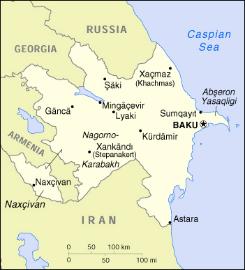
Measuring the magnitude of landmine injuries: Results of field testing
standardized survey tools in Azerbaijan.
Adam L. Kushner, MD, MPH, James C. Cobey, MD, MPH, Marie H. Nam, MD,
MPH.
As part of a public health approach to assist landmine victims, Physicians for
Human Rights (PHR) helped develop five standardized survey tools. These
tools include hospital surveillance, community sample, social reintegration,
hospital capability and orthpaedic center capability surveys. Methods: A
team from PHR field-tested the survey tools in Azerbaijan in June 1999. The
community sample and social reintegration surveys were administered to
landmine survivors and households in mine-affected districts. Surveillance
data on landmine injuries was collected from hospital records and capability
data was recorded from 12 hospitals and 2 orthopaedic centers in the capital,
Baku and the mine-affected districts. Results: Data on landmine victim
demographics and risk factors was collected from the Fizuli and Goranboy
districts. Eight landmine incidents were recorded in Fizuli in the preceding 12
months and 4 other cases were recorded at the Goranboy District Hospital.
Discussion: The survey tools proved effective in documenting the
magnitude of the landmine problem in Azerbaijan and the capacity of hospitals
and orthopaedic centers. Specific recommendations for Azerbaijan include
the need to develop a hospital based surveillance system, continue and
expand mine awareness programs and institute first aid training to vulnerable
populations.
standardized survey tools in Azerbaijan.
Adam L. Kushner, MD, MPH, James C. Cobey, MD, MPH, Marie H. Nam, MD,
MPH.
As part of a public health approach to assist landmine victims, Physicians for
Human Rights (PHR) helped develop five standardized survey tools. These
tools include hospital surveillance, community sample, social reintegration,
hospital capability and orthpaedic center capability surveys. Methods: A
team from PHR field-tested the survey tools in Azerbaijan in June 1999. The
community sample and social reintegration surveys were administered to
landmine survivors and households in mine-affected districts. Surveillance
data on landmine injuries was collected from hospital records and capability
data was recorded from 12 hospitals and 2 orthopaedic centers in the capital,
Baku and the mine-affected districts. Results: Data on landmine victim
demographics and risk factors was collected from the Fizuli and Goranboy
districts. Eight landmine incidents were recorded in Fizuli in the preceding 12
months and 4 other cases were recorded at the Goranboy District Hospital.
Discussion: The survey tools proved effective in documenting the
magnitude of the landmine problem in Azerbaijan and the capacity of hospitals
and orthopaedic centers. Specific recommendations for Azerbaijan include
the need to develop a hospital based surveillance system, continue and
expand mine awareness programs and institute first aid training to vulnerable
populations.
